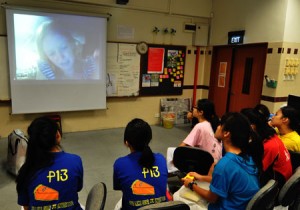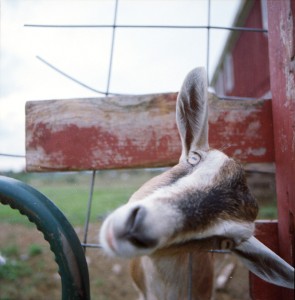As the artist-in-residence at an all-girls high school in Singapore, I have been working on an environmental project with the students. Twenty students and myself have each been carrying an IKEA bag in which we’ve collected our personal trash. I figured the best way to see how much junk we produce on a daily basis is to not throw any of it away. So, for the last sixty days, I have been carrying my IKEA bags everywhere I go, as a performance art piece that now weighs about 4kg [almost 9 lbs]. The girls–who I think are very brave to do this–have to explain to their mothers why they are keeping trash. I think this is awesome, because it is not exactly a very “lady-like” thing to do.
Teaching art in the school is great, especially because there is time set aside for the art students to learn art history (which I myself didn’t do until I went to university). Besides some local Southeast Asian art history, a good portion of the art history curriculum is based on Western art. The students are taught Romanticism all the way to Pop Art. Since I get to design some of the courses, I can teach a little bit of performance art, Land Art, and Conceptual art, which are my favorite dishes. Just last year, the school had its first-ever art trip to London and Paris to let the students see all the great masterworks in person. The experience was as invaluable as it was magical: the textbooks came alive!
This also points to one of the problems of teaching art on an island nation. Resources are somewhat limited, and every place else is a flight away. But Singapore’s advantage as a port city is its special relationship to the rest of the world (through economic trade, etc). I thought I would use that to my own advantage by bringing artists a little bit closer to the classroom. I have been running Foxriver, a small art space in the school, where I invite friends from different places to send works to be exhibited. Last year I had artists Gala Porras-Kim, Juka Araikawa, Krister Olssen, Josh Miller, Guan Rong, and Lindsay Foster, along with many other artists who participated in a comic book show curated by John Burtle.
The highlight, though, was when I invited Gala Porras-Kim to have an artist talk via Skype while her exhibition was on view in the space. So this week, I brought Louisa Conrad, a friend of mine from California Institute of the Arts (CalArts), to chat with the students about her experiences as an artist and her interest in environmental issues. Over the last three years, Louisa has spent time in Iceland photographing volcanic landscapes, researching sea pollution, and investigating the impact of industrial development on salmon. She has traveled throughout the Northwest Territories and the Canadian Arctic, and she now lives and works on a goat farm in Vermont called Big Picture Farm.
Below is an excerpt from our classroom’s Skype conversation with Louisa.
Mike HJ Chang: Can you tell us a little bit about the development of your practice?
Louisa Conrad: The development of my practice as an artist started with fish, and my interest in food systems and sustainability, which led me to think about my role as an artist. Instead of been an observer of systems, I wanted to be involved with a system of my own, a system which I am responsible for. So my husband and I have our own goat and sheep farm. Oh, our pigs eat all the leftovers on the farm, which would really help your trash project! As a farmer, I am functioning in the economic system and the environmental system. It is very much in line with what I had been doing before, research in science and natural history, so I see the farm as a long-term collaboration with the land and the animals.
We sell cheese and caramel. All the products people buy from us come with codes which link customers to our website, where they can see a video of what’s happening on the farm when their food is made. There is a particular relationship between customer and producer that I am interested in.
MC: How do you feel as an artist, now that you have a product that is part of the food industry?
LC: It’s really thrilling to have my product out there. Peter Schuman, the director of Bread and Puppet Theater in Vermont, has this saying that’s part of his Cheap Art Manifesto: “art is life, and art is for everyone.” Being able to make food that constantly goes into the world is a different feeling altogether from, say, working on a painting for six months. (To the students): So, how about your trash projects? What has been the most difficult part for you?
Girl: My parents think that keeping trash in the house is bad for Feng Shui.
LC: Oh yes, Feng Shui…yes, it doesn’t make your apartment look good! (Students laugh.) I’ve never been to Singapore, can you tell me where the food you eat in Singapore comes from?
Students: Everywhere! Malaysia, Australia, China, and Taiwan….
MC: People’s relationship to food is very different from that in the States. Most food here is imported, and I think everything from the supermarkets is over-packaged, which makes the trash project pretty tough.
Students: Do you prefer city life or life on the farm?
LC: I grew up in New York City and lived in Paris and Los Angeles. To live in the city I would have to have a more or less regular job to pay for all the expensive things. On the farm, I have a lot of control, like what I do during the day. Also we cook and eat like kings.
Student: Does your diet ever become repetitive on the farm?
LC: Lately I have been eating exclusively tomatoes. (Students laugh). In the winter, we have to eat a lot of pigs because we slaughter them in November. We also eat a lot of cheese. But overall I’d say it’s pretty good!
Student: Do you plan to have the farm for a long time?
LC: That’s a good question! It is hard for me to travel because we need to feed all the animals twice a day. So one day, when I make more money to hire helpers, I can go to Paris for a vacation.
*****
To me, Louisa is the perfect artist to talk to students. I see fewer and fewer contemporary Singapore artists working outdoors, and thus the exploration of relationships between man and nature on this concrete island is limited. Louisa’s works span across various types of landscape, giant and small, and across natural history as well as man-made phenomena. Not only does she work directly with nature, her scope expands across art into scientific research and history. And for me it is important to point out to the students that in contemporary practice, art is no longer just something that happens in the studio or on a canvas. It can vary in forms and methodology. And no matter what, it should always be something that questions our own relationships to our surroundings, environments, histories, and current ideas. While American high school kids are thinking about car stereos, parties, proms, and forgetting to prepare for the SAT (I am not saying these are bad things), I am teaching Singapore high school kids about interdisciplinary ideas such as art and environmental issues (I am saying these are good things). All joking aside though, HINT: American schools, art teachers ARE important. Duh!
One last thought about living on a small island: I wonder if interdisciplinary study isn’t even more important, given the proximity of physical space, time, and the related-ness of everything? I’m thinking about racial problems and aesthetics, architecture and human memory, education and phenomenology à la Maurice Merleau-Ponty, and so forth.





